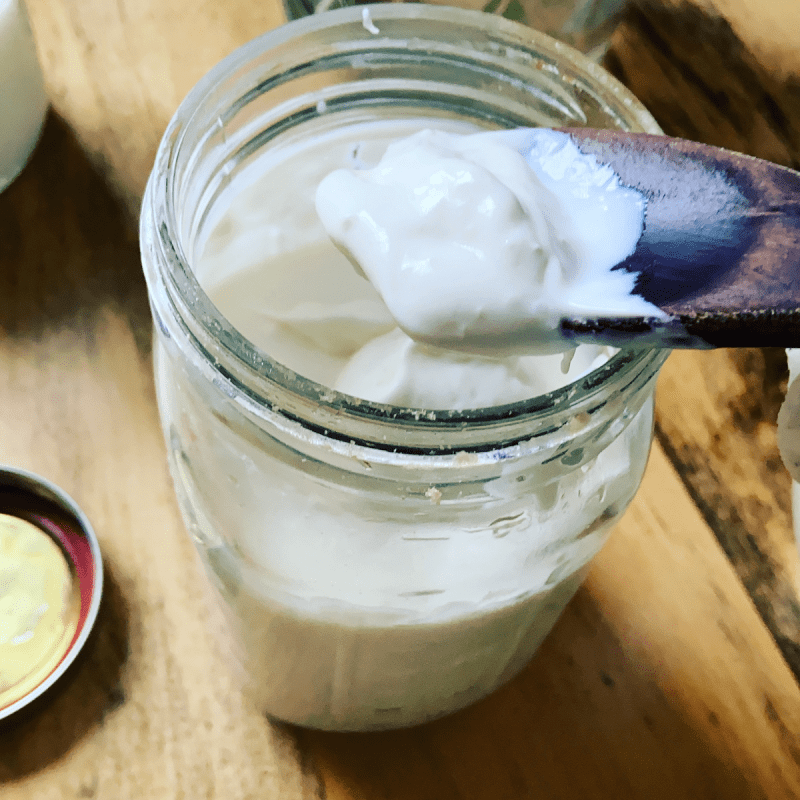This is a first in a series about my favorite recipes that I regularly make for my family. I like to suggest this recipe among many others to my clients as they learn about Food as Medicine and the sadhana or spiritual practice of making our own food from scratch. In this practice, we create a deeper connection with our food and food sources. We benefit from the freshest foods alive with Prana (life force), and we get to infuse food with our loving energy for ourselves and our family. Not to mention that the results are delicious. It’s a win-win!
Why homemade yogurt?
- Very simple to make especially if you have an Instant Pot.
- Extremely delicious. It has such a wonderful mild, creamy taste.
- Not sour at all so it’s more Pitta-friendly.
- Super fresh and therefore more nutritious.
- Easier to digest than store bought because it’s fresh.
- No additives, of course.
- The best probiotic that you can make yourself to feed your gut daily.
- Very affordable compared to buying store bought.
- Also get homemade buttermilk and whey as bonus products.
- Replaces sour cream beautifully.
Yogurt is an Ayurvedic diet staple
The Ayurvedic diet favors fresh dairy best because it hasn’t been sitting around for a long time and become sour. Sour yogurt increases the Pitta dosha, which increases heat in body and mind. Not always a good thing. Old food in general has less nutrition, less Prana (vital life force), and can also creates ama (toxins). This is because old food doesn’t digest well and can leave a post-digestive residue (ama) that gets released into our system and causes all sorts of havoc – mainly inflammation.
Yogurt qualities are cold and heavy. Greek yogurt is more dense, too. These are not the best qualities for proper digestion so we try not to eat too much of it too early or too late in the day when digestion is not its strongest. We might have a dollop of it with cooked fruit or pancakes in the morning or with a little homemade granola as a snack in the afternoon. In general, we use it for lassis or our daily probiotic drink.
To counteract it’s cold, heavy qualities I add dashes of warming spices like cinnamon and cardamom. Cardamom in particular helps to digest milk products. To make it less chilly, I take portions out of the fridge a head of time so they can warm to room temperature. I might also drizzle it with honey, which is also warming. The best is when I’ve made the yogurt fresh in the morning before it’s been refrigerated.
The traditional way to have yogurt is by way of a lassi. A lassi is basically diluted yogurt and a pinch of salt and digestive spices. So simple and easy. This is the best way to take it for its probiotic benefits. A small amount is typically enjoyed at lunch time, when our digestion is strongest. See below for the recipe.
The Recipe: Homemade Yogurt Ingredients:
- 8 cups plain whole milk, organic preferred (1/2 gallon)
- 2 Tablespoons of plain whole milk yogurt (make sure there’s active bacterial cultures and no additives in the ingredients – or use some from your last homemade batch).
- OR 1-2 teaspoons of yogurt starter (Here’s the yogurt starter I suggest that makes the best probiotic yogurt)
I suggest using a good probiotic yogurt starter like Natren in your first batch and using it every few batches to keep the bacterial cultures strong.
I like to keep 2 Tablespoons of freshly made yogurt in the freezer to use as my starter next time. I’ll use Naten’s starter every few weeks (we make yogurt weekly) to keep the bacterial cultures strong. I’m too much of a kitchen economist to use it every time! A $20 a bottle makes 30 quarts or 15 half gallon batches That’s nearly 4 months of continuous weekly yogurt making.
Instant Pot Instructions I usually start yogurt at night since it needs to sit overnight.
- Pour milk into Instant Pot insert (inner pot). Close and secure the lid.
- Bring to a boil using the Yogurt function (press the button until you see “boil”).
- After the milk boils, remove the insert and let it cool down for about 30-40 minutes.
If you’d like to speed this process up you can put the pot in your sink filled with ice water. That will take about 10 minutes. You know it’s cool enough when you can keep your finger in it (about 108-115F degrees). The milk has to be warm, however, so don’t let it get too cool. If this has happened, you can put the insert back into the Instant Pot and use the Warm function to warm it again.
- Put a little of the warm milk in a cup and add the yogurt or starter. Stir to combine well.
- Pour the warm milk and yogurt/starter mixture into the insert and stir to combine well.
Put the insert into the Instant Pot and use the Yogurt function to choose “8:00.”
- Let sit overnight. When it’s done it will read “Yogurt.”
- You can eat it as it is or you can strain it to make Greek-style yogurt.
Instructions if you don’t have an Instant Pot
- Heat milk in a pot on the stove to 180F degrees to scald the milk. Watch carefully so it doesn’t boil over! Once you see froth and a few bubbles surfacing you can turn if off. Take it off the heat and allow to cool.
- When boiled milk is nearly cool, warm the oven by preheating it for 5 minutes on the lowest temperature. Turn off the oven.
- Once the milk has cooled, add yogurt or yogurt starter.
- Transfer the milk to glass jars with lids if you’d like.
- Keep the yogurt inside the warm oven over night and wrap with kitchen towels for insulation.
- Leave the oven light on to maintain some warmth.
- You can also use a heating pad under the bowl or jars and leave covered yogurt on your counter top. Surround with towels to keep the heat in. You can also do this in a cooler with a heat pad and insulated with towels.
My family and I like Greek-style yogurt the best so I strain the yogurt after I make it. However, before I do this I set aside 2 to 3 cups to make buttermilk and lassis. See recipes below.
To make Greek-style strained yogurt When the yogurt is ready in the morning, I strain the remainder in a fine sieve colander lined with cheese cloth for a couple hours. This will make less yogurt, of course. This is how you get whey from the recipe.
Whey is the liquid that is strained from the yogurt. The more you strain, the more you’ll get. I usually get 3-4 cups in one 1/2 gallon batch. I use it recipes and mostly for soaking grains overnight when I’m making bread or pancakes.You can also use it in cooking any dish that calls for water or broth.
To make buttermilk,I reserve 1 cup of yogurt (before straining) and blend it with 4 cups of water until frothy. Remove the froth and put it in a glass jar to keep in the fridge.
That’s it! No need for vinegar that increases Pitta heat.
I use this for pancakes and other baked goods, bread making, and creamy dressings.
To make a lassi, use a 1/4 cup of yogurt (strained or not) and add 3/4 cup of filtered water. That’s it!
If you’re getting the yogurt fresh from the fridge you can use warm water to take the chill off; however a cool lassi is the best during the heat of the summer. I like to put this in a little jelly jar and give it a good shake. I like to make a double batch that my kids and I will drink with lunch. A serving is about a cup. Avoid drinking large quantities of anything with meals to strengthen digestion (agni).
Anything with blended fruit or ice is not a traditional lassi, rather an American adaptation. Combining fruit and yogurt is a dietary no-no in Ayurvedic nutrition. You don’t want to find out why. Bloat City!
Here are a few of my favorite variations:
- Sweet: dash of salt, dashes of ground cardamom, cinnamon, and/or ginger, drizzle of honey.
- Savory: dash of salt, dashes of ground cumin and/or coriander.
- Sweet and Savory: all of the above!
- Golden: add a few dashes of ground turmeric.
- Green: dash of salt, ground cumin or whole cumin seeds, small handful fresh cilantro and/or mint leaves, drizzle of honey. Blend away!
Why salt? Salt is added as a digestive. It’s optional but it does also enhances the taste.
I hope you try making your own yogurt. I think it’s totally worth it. It’s so delicious it doesn’t last long in our house.
Good luck! Let me know how it goes.




0 Comments